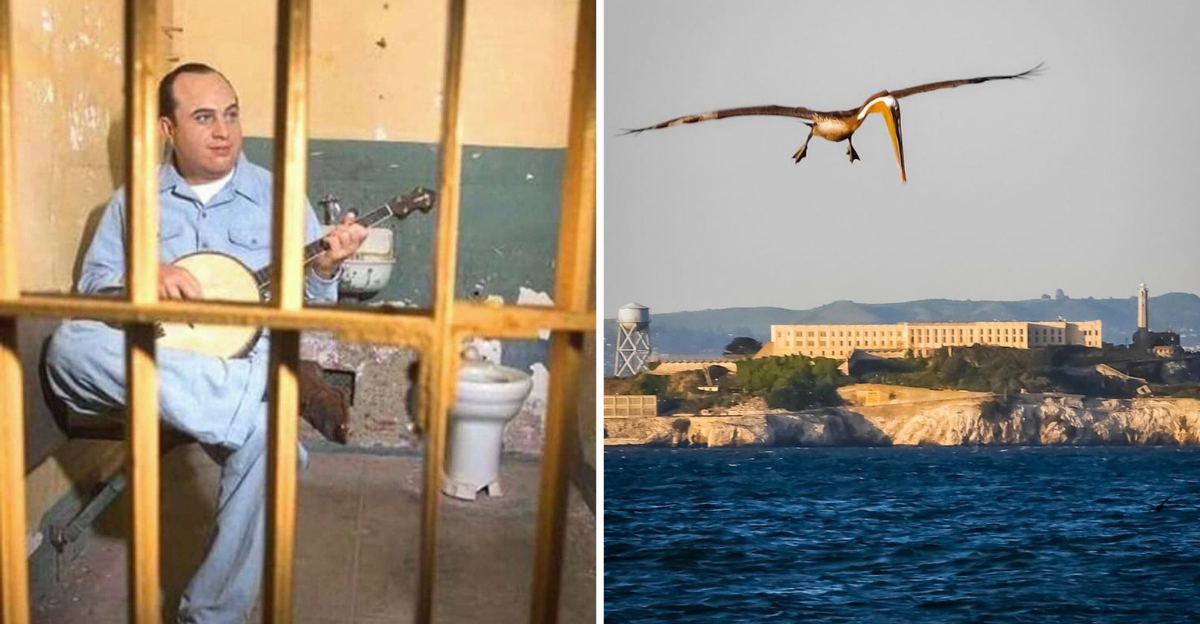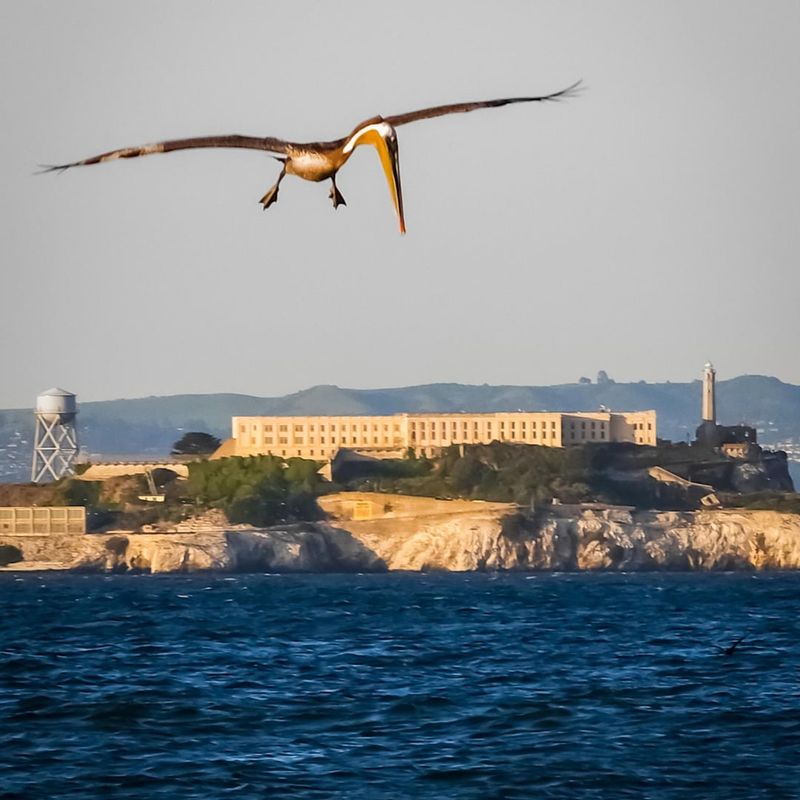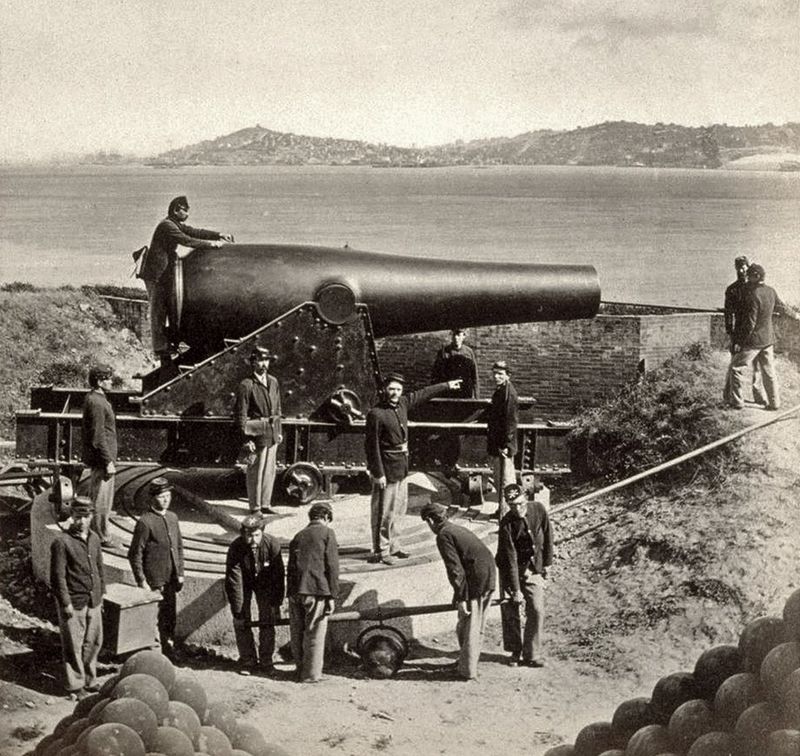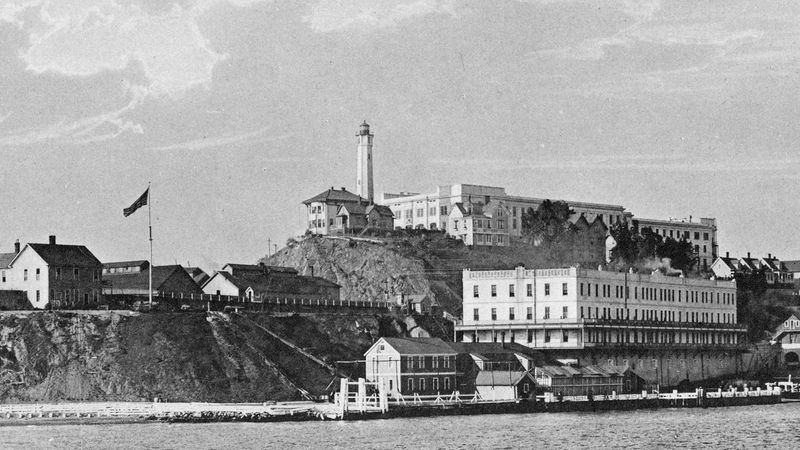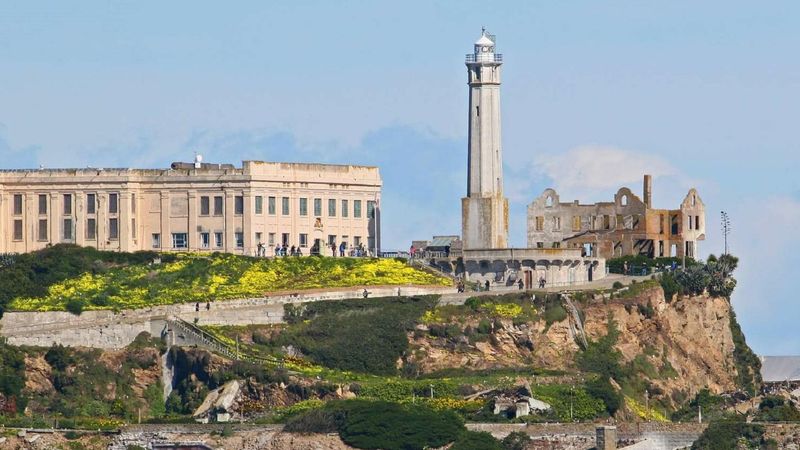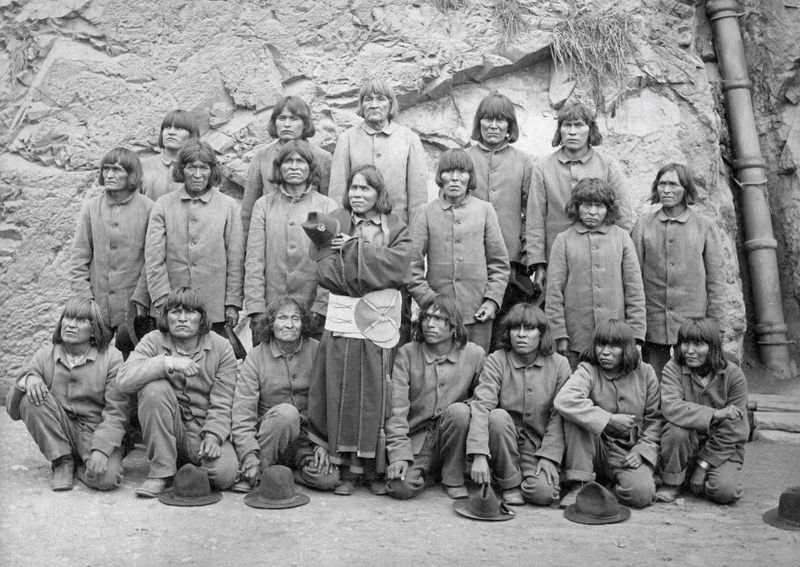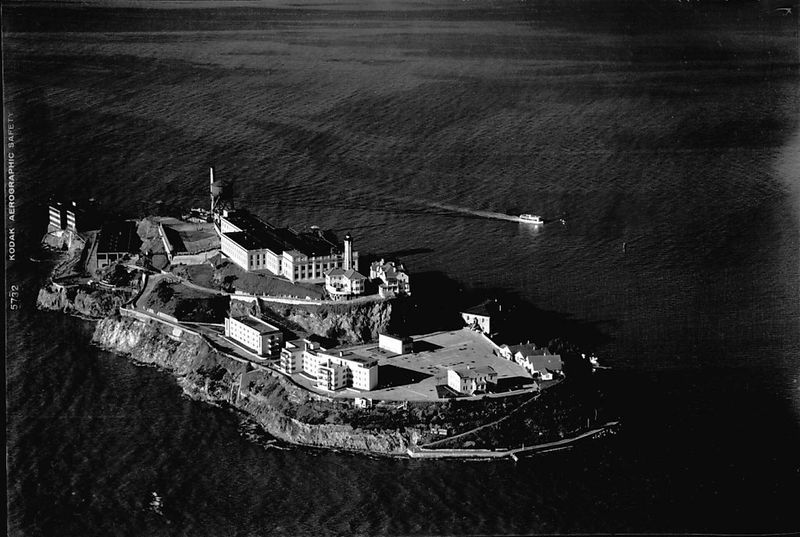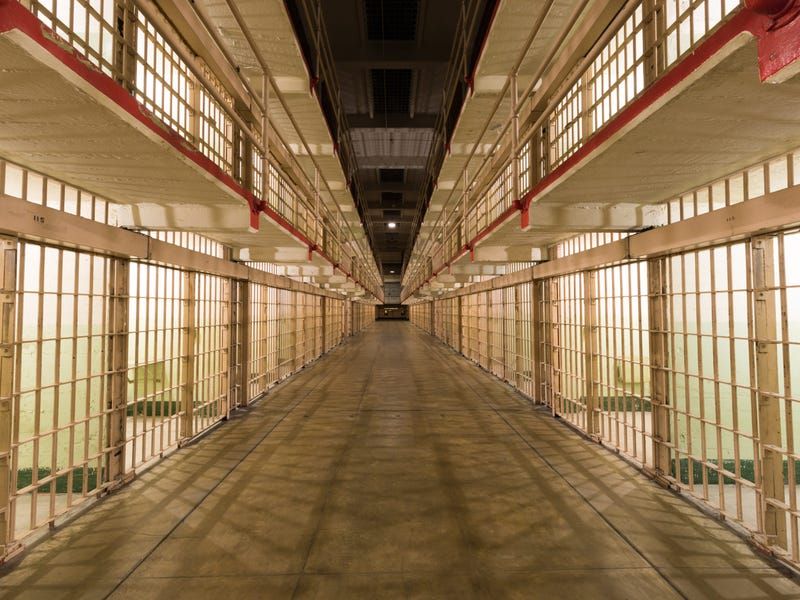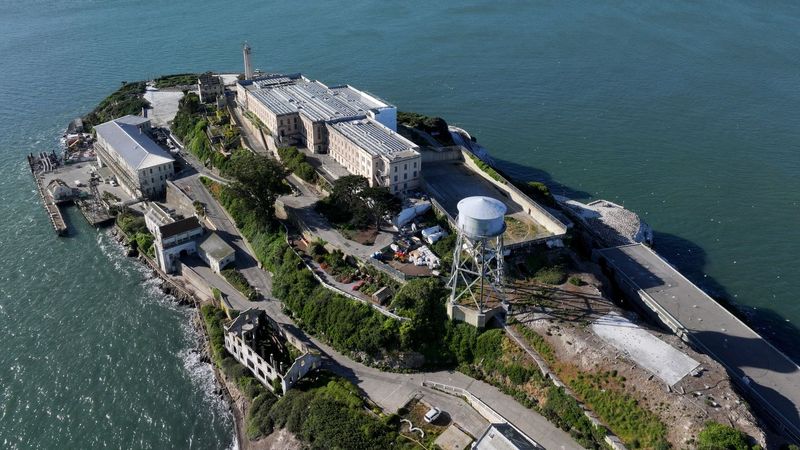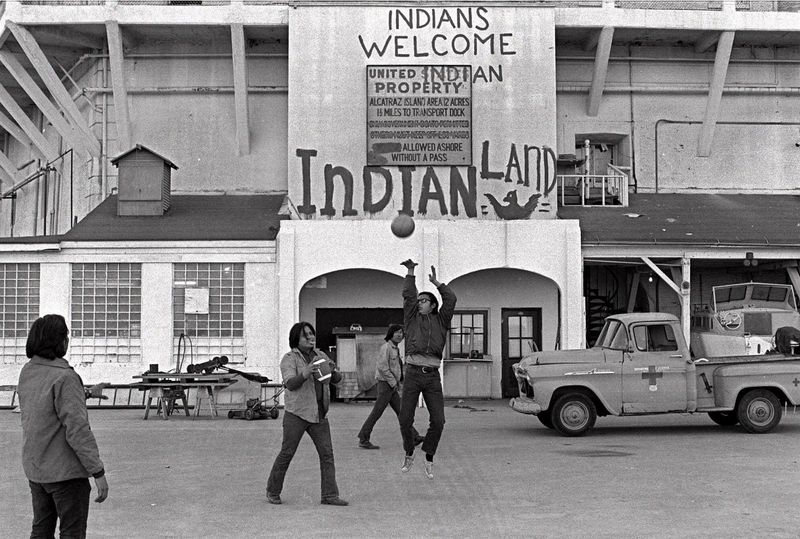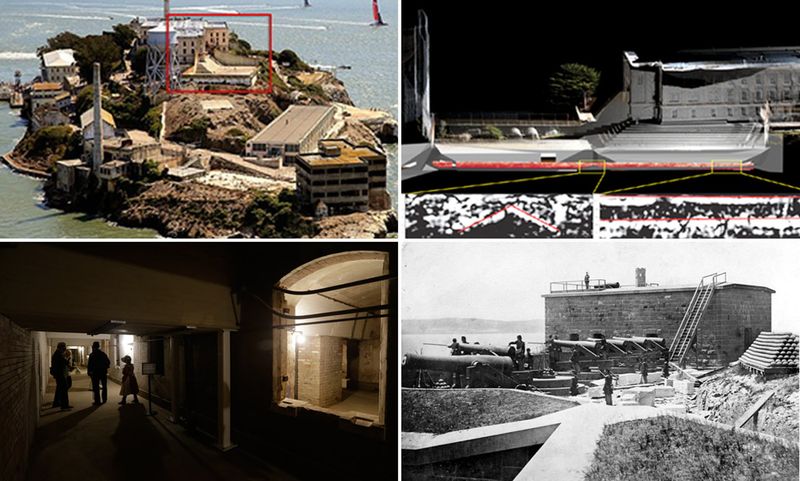Alcatraz Island sits in San Francisco Bay, a place most people know as a tough prison for the worst criminals. But this small island has stories that go way beyond jail cells and famous gangsters. From its early days as a military fort to becoming a symbol of Native American rights, Alcatraz has played many roles in American history.
1. Birds Gave Alcatraz Its Name
Spanish explorer Juan Manuel de Ayala spotted the island in 1775 while mapping San Francisco Bay. The rocky outcrop was home to large colonies of seabirds, particularly pelicans, which led him to name it “Isla de los Alcatraces” – Island of the Pelicans.
Over time, the name simplified to Alcatraz. Though most pelicans have moved to less crowded nesting grounds today, the island’s avian heritage lives on in its name.
Seagulls remain the primary bird residents now, their cries echoing across the water as a reminder of the natural world that existed long before humans built prisons there.
2. Military Fortress Before Prison Cells
President Millard Fillmore transformed Alcatraz into a military stronghold in 1850, years before any criminals arrived. Engineers constructed massive brick walls and mounted 105 cannons to protect San Francisco during the gold rush era.
Soldiers stationed there lived in barracks, not cells. The fortress never fired a shot in battle despite its impressive firepower.
You can still see remnants of this military past today beneath the prison buildings. The old fortress walls served as the foundation for the later federal penitentiary, literally building America’s most notorious prison on top of a defensive military base.
3. Confederate Prisoners Locked Up During Civil War
During America’s bloodiest conflict, Alcatraz held its first prisoners – but they weren’t criminals in the traditional sense. Confederate sympathizers, privateers, and citizens suspected of aiding the South found themselves locked in the island’s dungeons.
The military prison’s isolated location made escape nearly impossible. Some prisoners were wealthy San Franciscans who merely expressed Southern sympathies.
Conditions were harsh, with men crowded into damp underground chambers originally designed as storage for ammunition and supplies. This little-known chapter marked Alcatraz’s first role as a place of confinement rather than defense.
4. West Coast’s First Lighthouse Still Shines
Rising 214 feet above sea level, Alcatraz’s lighthouse first cast its beam across the foggy bay in 1854, becoming the Pacific Coast’s first navigational light. Ships entering the treacherous Golden Gate Strait depended on its guidance decades before the famous bridge spanned those waters.
The original structure was damaged in the 1906 earthquake. Workers built the current concrete lighthouse in 1909, which continues operating today.
While thousands of visitors focus on prison cells and famous inmates, the lighthouse has served continuously for over 165 years – outlasting the military base and the federal prison as the island’s most enduring feature.
5. Hopi Men Imprisoned for Protecting Their Culture
Long before gangsters arrived, Alcatraz held 19 Hopi men from Arizona in 1895. Their crime? Refusing to send their children to government schools that would erase their language, religion, and culture.
The men were separated from their families and transported over a thousand miles to break their resistance. They endured hard labor and isolation while maintaining their spiritual practices in secret.
After nearly a year, authorities released them when they realized imprisonment wouldn’t change their resolve. This forgotten chapter represents one of America’s earliest indigenous resistance movements against forced assimilation, decades before the island became a federal penitentiary.
6. The Great Depression Created a Federal Prison
Alcatraz transformed into America’s first maximum-security federal penitentiary in 1934 amid the Great Depression’s crime wave. Gangsters like Al Capone had exploited Prohibition, while bank robbers like John Dillinger became folk heroes to struggling Americans.
Attorney General Homer Cummings convinced President Roosevelt that a super-prison would show the public that crime wouldn’t pay. The Justice Department specifically designed Alcatraz to house troublemakers from other prisons who couldn’t be controlled elsewhere.
The first boatload of 137 prisoners arrived in August 1934, transferred under heavy guard from places like Leavenworth and Atlanta. Many wouldn’t see the mainland again for decades.
7. Nature Created the Perfect Prison Security System
Alcatraz’s natural defenses made it an escape-proof nightmare. Freezing water temperatures averaging 50°F caused hypothermia within minutes. Powerful currents reaching 6-8 knots swept swimmers toward the Pacific Ocean rather than the nearby shores.
Guards told prisoners the bay was shark-infested to discourage escape attempts. While great whites occasionally enter the bay, the prison exaggerated this threat.
Only 36 men in 14 separate attempts tried escaping by water. Official records claim none succeeded, though the famous 1962 attempt by Frank Morris and the Anglin brothers remains classified as “missing and presumed drowned” – leaving room for America’s most enduring prison mystery.
8. Capone’s Musical Prison Days
Al Capone, America’s most notorious gangster, couldn’t bribe or intimidate his way to special treatment at Alcatraz. The man who once controlled Chicago spent his days making shoes in the prison workshop like any other inmate.
His only comfort came through music. Capone practiced banjo in his cell for hours, eventually joining the inmate band called the “Rock Islanders.” Fellow prisoners recalled hearing him play “Sweet Adeline” repeatedly.
Syphilis gradually destroyed his mind during his imprisonment. By the time of his transfer to Terminal Island in 1939, guards reported he would sit on his bed playing imaginary instruments and holding conversations with people who weren’t there.
9. Blood-Soaked Battle Rocked The Rock
The spring of 1946 erupted in America’s deadliest prison riot when six inmates seized weapons from an officer. The desperate men took nine guards hostage, demanding a boat to escape the island.
For 48 horrifying hours, bullets flew through cellblocks as Marines and prison guards fought to retake control. Two officers were killed, along with three inmates.
Bernard Coy, the mastermind who had spent months dieting to squeeze through cell bars, died in the gunfire. The battle ended when guards stormed the cellblock with overwhelming force. Two surviving ringleaders later died in the gas chamber at San Quentin, becoming the only Alcatraz inmates executed for crimes committed inside the prison.
10. Not The Hellhole Hollywood Imagined
Despite its fearsome reputation, Alcatraz offered better living conditions than most prisons of its era. Each man had his own cell – a rare privilege when other facilities packed inmates into crowded dormitories.
The food ranked among the best in the federal system. Former prisoners often mentioned the quality meals as one positive aspect of their time on The Rock.
Hot showers were available, though this wasn’t a luxury – officials wanted inmates unaccustomed to the bay’s cold water to discourage escape attempts. The library contained thousands of books, and silence rules were eventually relaxed to allow conversation during meals and recreation times.
11. Money Problems Sank The Rock
Alcatraz closed in 1963 not because of escapes or violence, but because of basic economics. Running the island prison cost three times more than other federal facilities – an expense the government couldn’t justify.
The island had no natural water source. One million gallons of freshwater had to be barged in weekly for drinking, cooking, and washing.
Salt air and water mercilessly corroded buildings, requiring constant repairs. Metal pipes, window frames, and cell bars rusted rapidly, while concrete crumbled from saltwater exposure. Attorney General Robert Kennedy finally ordered the prison closed, with remaining inmates transferred to other facilities like the newly-built penitentiary in Marion, Illinois.
12. Native American Warriors Reclaimed The Island
After sitting abandoned for six years, Alcatraz became the site of the most significant Native American protest of the 20th century. On November 20, 1969, 89 activists from various tribes occupied the island, claiming it under an 1868 treaty that promised surplus federal land to Native people.
The occupation lasted 19 months, drawing global attention to indigenous rights. Participants created a functioning community with a school, clinic, and radio station.
Though federal marshals forcibly removed the last protesters in June 1971, the occupation succeeded in changing federal policy. President Nixon ended the disastrous “termination” policy that eliminated tribal status and launched a new era of tribal self-determination.
13. Hollywood’s Favorite Prison Myths
Films like “Escape from Alcatraz” (1979) and “The Rock” (1996) cemented Alcatraz’s place in pop culture while creating lasting myths. Clint Eastwood’s portrayal of escapee Frank Morris showed him navigating steam tunnels that don’t actually exist beneath the prison.
Sean Connery’s character claimed to be the only man who escaped Alcatraz, contradicting historical records. The movies invented torture dungeons, secret rooms, and elaborate underground networks.
Reality was both less dramatic and more interesting than Hollywood imagined. The actual prison had no execution chamber, no dungeons with tide-filled cells, and no flamethrowers. Yet these fictional elements have become so embedded in public consciousness that many visitors express disappointment at not finding them.
14. America’s Most Popular Former Prison
From forbidding penitentiary to tourist hotspot, Alcatraz underwent a remarkable transformation. The National Park Service took control in 1973, opening the island to visitors who now number over 1.5 million annually.
Tickets for the ferry and prison tours often sell out weeks in advance during peak season. Former guards and inmates occasionally return to sign books and share stories with fascinated visitors.
Beyond the cellblocks, the island offers surprising natural beauty. Gardens planted by prison staff families have survived decades of neglect, while protected seabird colonies nest on the cliffs. The island’s dual identity as both natural sanctuary and historical site makes it one of America’s most unusual national parks.
15. Secret Tunnels Beneath Prisoners’ Feet
Recent archaeological discoveries revealed a hidden Alcatraz beneath the prison yard. Using ground-penetrating radar in 2019, scientists found Civil War-era tunnels, ammunition magazines, and a massive “bombproof” earthwork completely intact under the recreation yard where Al Capone once exercised.
These 19th-century military structures were simply covered over rather than demolished when the prison was built. Some tunnels still contain original brick floors and ventilation systems from the 1860s.
Most prisoners had no idea they were walking above a complex underground fortress daily. Archaeologists continue finding artifacts from different periods of the island’s history, including buttons, coins, and personal items from soldiers who served decades before the first federal prisoners arrived.
